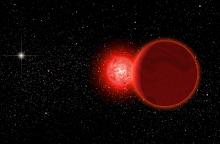Listen to today's episode of StarDate on the web the same day it airs in high-quality streaming audio without any extra ads or announcements. Choose a $8 one-month pass, or listen every day for a year for just $30.
You are here
Moon and Spica
A star that’s always two and a half centuries behind the times perches to the lower left of the Moon this evening.
Spica is the leading light of Virgo, and the 16th brightest star in the night sky. It dazzles even though it’s farther than most of the other members of the Top 16. That tells us that Spica doesn’t just look bright, it really is bright.
Spica’s distance has been measured at 250 light-years. That’s the distance covered by a beam of light — which travels at 670 million miles per hour — in 250 years. So the light we see from Spica tonight actually left the star 250 years ago.
There’s a bit of wiggle room in that distance, though — about 10 light-years in either direction.
In part, that’s because of the technique that’s used to measure distances to stars that are fairly close — like Spica. Astronomers compare the star’s location relative to the stars around it when Earth is on opposite sides of the Sun. That change in viewing angle causes the star to appear to shift back and forth a tiny bit compared to the background. The size of the angle reveals the star’s distance. But as the distance increases the angle gets smaller, which makes it harder to measure — hence the margin of error.
A 10-light-year uncertainty isn’t a big problem for astronomy. But it would be a problem for a starship headed to Spica. Without a precise distance, the ship might stop short or travel too far — missing brilliant Spica.





